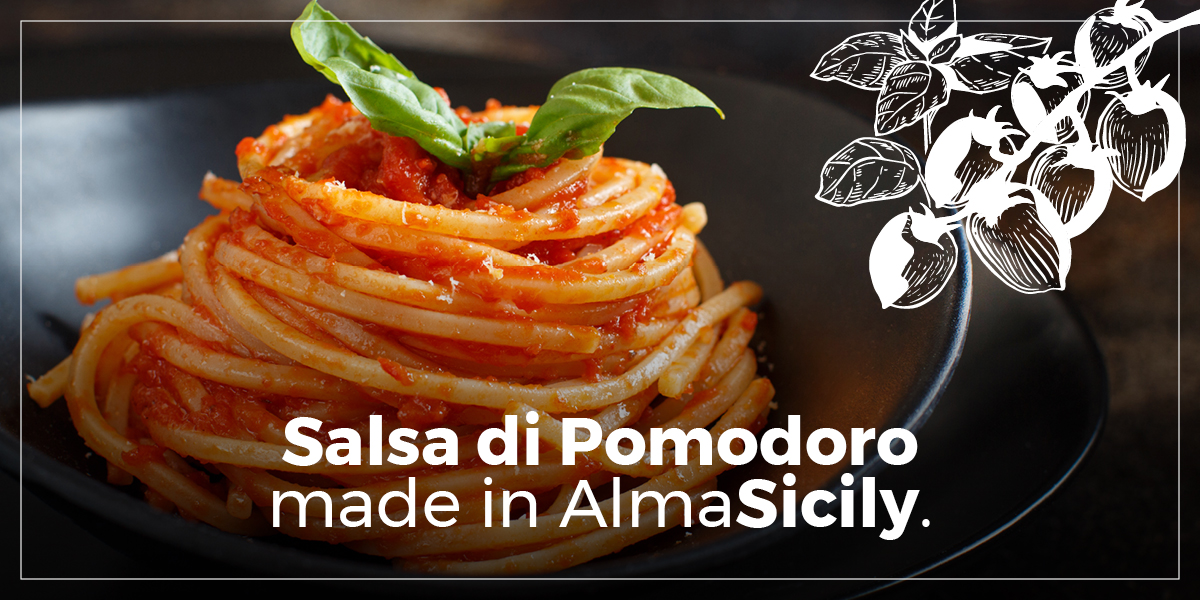Among the moments lived during childhood I remember with great affection the preparation of the tomato sauce which needed throughout the following year to accompany the preparations of a slow cuisine, of memory and great flavor.
All over the place juicy tomatoes, women chattering, full smells, full sounds. Those notes marked the summer days, and somehow it was a holiday at least for us children.
I can still feel that smell and taste sometimes. And maybe for the same reason I’ve honestly never been able to buy sauces in large retailers. That clean red never gave me confidence. And then, by chance during a holiday in Sicily I come across by chance in a tomato sauce made in a traditional way according to the methods and the original recipe. from an all Sicilian company that points to authenticity and quality, made by an all Sicilian company that aims at authenticity and quality.
Undecided between the cherry tomato sauce and the datterino one, I uncorked the first bottle of tomato, and that smell brought me back in time, accompanied me in a land that I knew only as a tourist.
The tomato sauce lends itself to countless recipes related especially to Mediterranean cuisine, but my favorite version is certainly with spaghetti al dente and a fresh basil leaf, so I did it to try the quality of this 100% sauce made in Sicily. Result? Intense, sweet and authentic flavor!
From the nutritional point of view, the tomato is very rich in water and low in calories, with a decent fiber content. It has a good amount of potassium and a reduced sodium content.
It is important also to underline the antioxidant property of tomato due to both vitamin C and lycopene. Vitamin C is water-soluble and thermolabile, lycopene is a carotenoid, fat-soluble, actually responsible for the red color.
Their content and bioavailability are strictly linked to the way of consumption.
Antioxidants protect our body from oxidative stress, which accompanies aging and in general stressogenic processes in our body.
C Vitamin is mainly present in fresh tomatoes, while the bioavailability of lycopene increases up to five times more with cooking. In fact, the heat helps to break the cell walls within which it is contained, freeing it and making it more available for intestinal assimilation.
The fat-soluble nature of lycopene requires a fat substance, therefore a lipid, to be assimilated. And so, the extra virgin olive oil becomes a perfect match suggested by our Mediterranean tradition for consumption with cooked tomato sauce. There is nothing better to fill up with antioxidants throughout the year.
The tomato is a vegetable, grown in central-southern Italy. It is predominantly red, which becomes full thanks to the warm sun rays that pamper it throughout the summer. There are several varieties used in both raw and cooked packaging.
Tomatoes are berries of the species Solanum lycopersicum, a plant belonging to the family of Solanaceae. Native to South America, at the end of 1700 it is documented the cultivation in Europe for alimentary purposes. Today the tomato is consumed all over the world and Italy is the first producing country in Europe.
The fresh consumption takes place mainly from June to September, but the various methods of preservation, such as the production of sauces, peeled or dried tomatoes, ensure that the product is available all year round.
Eating is certainly a pleasure that cannot overlook the quality of the raw material.
Quality depends on cultivation methods, place of origin, and processing methods. All these characteristics influence the nutritional content of each food, even more true if we speak of the plant world. It is therefore a duty for our health to choose carefully what we put at the table.
It is necessary for the consumer to know that the nutritional quality of the vegetables and therefore also of the tomato is strongly influenced by the mode of cultivation.
The difference between a tomato that grows naturally in the open air and one in the greenhouse is not in colour, neither in shape, nor of course in its final use, but in its nutritional value.
When they are still harvested unripe, stored in the fridge and matured in rooms with ethylene, harmless to human health, have a significantly lower vitamin and antioxidant content. On the contrary, the product grown in heated greenhouses has nutritional characteristics similar to the product grown in the field, but certainly does not have the same organoleptic characteristics.
The cultivation in open field is the best condition for the plant world, which allows you to take advantage of the best nutritional properties and organoleptic qualities.
Here are the 6 factors to consider to choose a high quality tomato sauce:
- Place of cultivation of the raw material
- Origin and type of tomato
- Method of collection
- Ingredients used in the recipe
- Place and method of processing and storage
- Size of the agricultural holding responsible for the cultivation
One of the main reasons why I liked the Sicilian tomato sauce Almasicily is that the tomatoes used grow exclusively in Sicily in a fertile soil, and ripen spontaneously outdoors, and at the end of their life cycle are harvested by hand not to alter the unique characteristics of Sicilian tomatoes. The good weather of the Sicilian territory, the constant exposure to sunlight and an ancient agricultural tradition transfer to the tomatoes its precious nutritional characteristics.



There are no reviews yet.